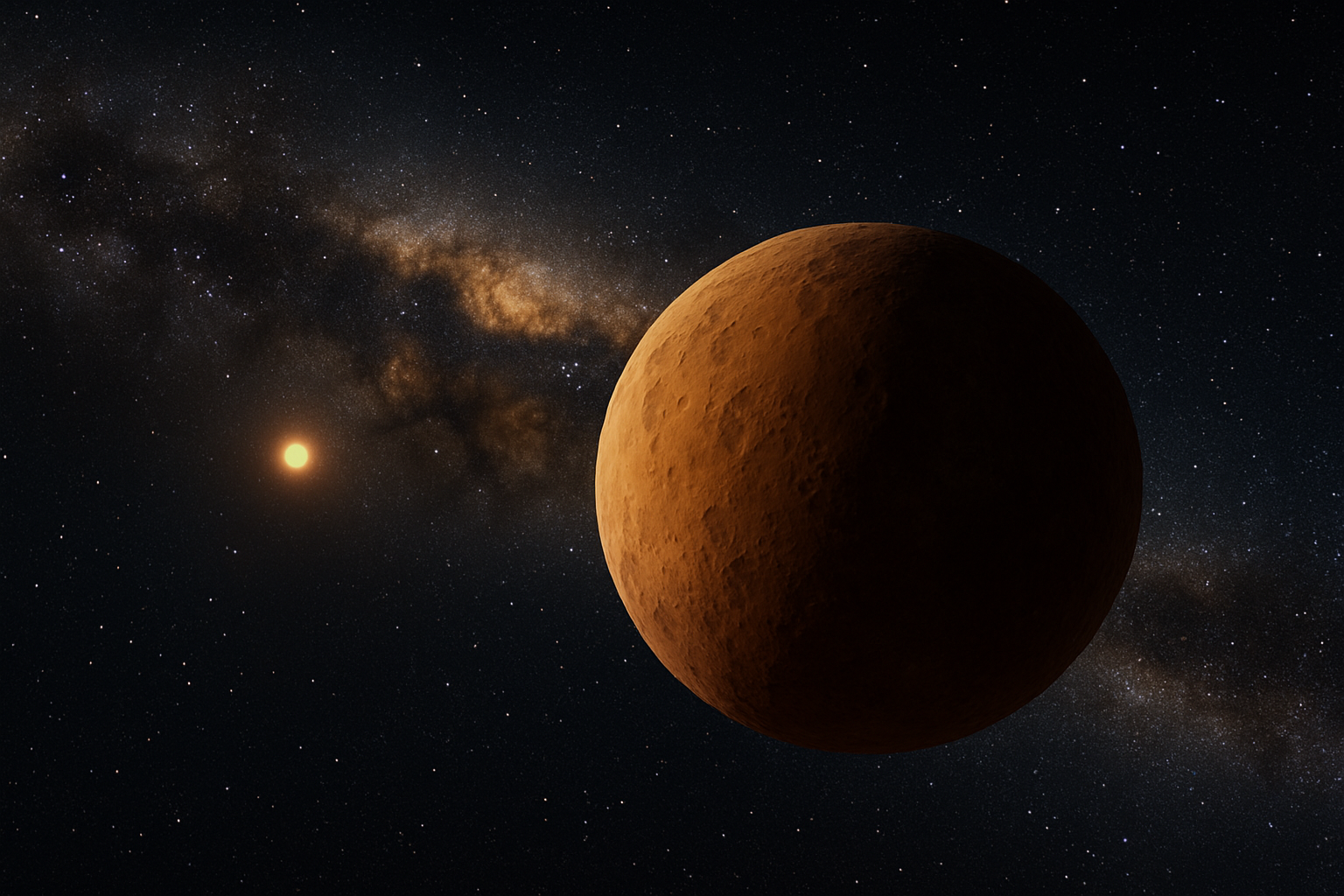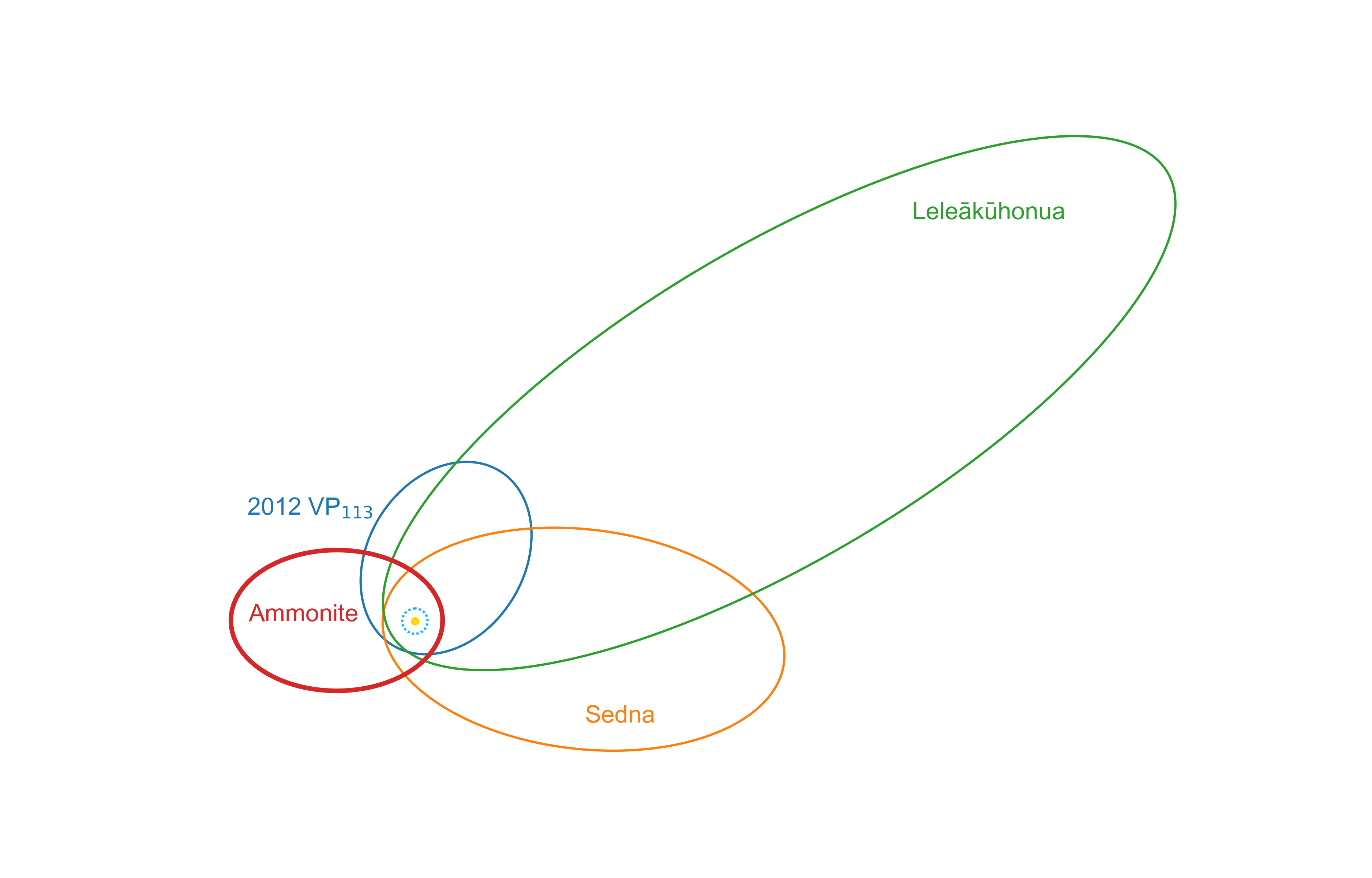Date: 2025-07-15
Astronomy enthusiasts have been diligently searching for the Solar System’s “Planet Nine.” Is there finally a glimmer of hope? An international project led by Dr. Shiang-Yu Wang and Dr. Ying-Tung Chen from the Institute of Astronomy and Astrophysics, Academia Sinica (ASIAA), has discovered a distant Solar System object, 2023 KQ14, nicknamed “Ammonite,” using the Subaru Telescope in Hawaii. Ammonite follows a stable orbit with a perihelion distance of 66 astronomical units (au), placing it in the extremely rare category of “Sedna-like objects” (also known as Sednoids), whose orbits lie far beyond the gravitational influence of Neptune. Notably, Ammonite shows a markedly different orbital orientation from known Sedna-like objects in the Solar System. This surprising contrast sheds light on the complexity and evolutionary history of this distant population, and may reduce the likelihood that Planet Nine exists. The discovery was published on July 14, 2025 in Nature Astronomy.
An Opposite Orbit Challenges the Existence of Planet Nine
The defining feature of Sedna-like objects is their perihelion—the closest point to the Sun in their orbits—lying far beyond Neptune’s orbit (approximately 30 au). Previously, the only known objects staying this far from the Sun were Sedna (perihelion ~76 au), 2012 VP₁₁₃ (perihelion ~80 au), and Leleakuhonua (perihelion ~65 au). Their unusual trajectories hint at hidden forces in the Solar System—possibly a long-lost planet, a stellar encounter billions of years ago, or the presence of an undiscovered planet, sometimes referred to as Planet Nine.
Dr. Ying-Tung Chen, the first author of the study and a Support Scientist in ASIAA, pointed out that Ammonite is the fourth discovered Sedna-like object. What makes Ammonite particularly noteworthy is its position in orbital parameter space: it lies within a previously nearly empty region with perihelion distances between 50 and 75 au and semi-major axes between 180 and 600 au. For years, astronomers debated whether this gap was due to observational limitations or a true dynamical feature shaped by unseen gravitational influences. With advances in telescopes and sky surveys, scientists can now detect objects in this once-overlooked region.
Dr. Chen emphasized that while previously known Sedna-like objects all share roughly similar orbital orientations, Ammonite’s orbit is oriented in the opposite direction. Ammonite’s unique orbit suggests that the outer Solar System is more diverse and complex than previous perceptions. If the Planet Nine scenario is true and such a planet exists, then the reason Ammonite's orbit does not cluster with that of the other members will need to be investigated. The existence of Ammonite also limits the possible orbital parameters of Planet Nine. "Finding Ammonite is like discovering a missing piece of the puzzle at the Solar System’s frontier," said Dr. Chen. “It expands our understanding of the orbital distribution of extremely distant trans-Neptunian objects.”
“The significance of discovering Ammonite goes far beyond adding one more distant object,” said Dr. Shiang-Yu Wang, the corresponding author and a Research Fellow in ASIAA. “Ammonite’s orbit tells us that something sculpted the outer Solar System very early on. Whether it was a passing star or a hidden planet, this discovery brings us closer to the truth.”
A Stable Orbital Fossil from the Early Solar System
The team used the powerful 8.2-meter Subaru Telescope located on Maunakea, Hawaii. Subaru's wide-field imaging capabilities are uniquely suited to scanning large patches of the sky for faint, slow-moving objects like Ammonite. It is equipped with the Hyper Suprime-Cam, the most powerful camera to detect distant Solar System objects developed jointly by National Astronomical Observatory of Japan (NAOJ) and ASIAA. To confirm its orbit, the team followed up with observations in 2024 using the Canada–France–Hawaii Telescope (CFHT), which operates in a flexible queue mode ideal for time-sensitive discoveries. Both the Subaru telescope and CFHT are long-term collaborators of ASIAA. In addition, the researchers analyzed archival data spanning more than a decade to verify Ammonite’s trajectory and refine its orbital parameters.
Computer simulations indicate Ammonite’s orbit has remained stable for billions of years, unaffected by gravitational interactions with other Solar System objects. This long-term stability makes Ammonite one of the best-preserved "fossils" of the Solar System’s distant past, suggesting that it originates from the Solar System’s early formation and retains a fossil record of the orbital configuration. Intriguingly, another simulation shows that about 4.2 billion years ago, Ammonite and other Sedna-like objects may have shared a clustered orbital alignment—possibly influenced by a long-lost planet in the outer Solar System.
This international research is part of the Formation of the Outer Solar System: An Icy Legacy (FOSSIL) project. The team includes scientists from National Central University in Taiwan, NAOJ, Kinki University in Japan, the National Research Council of Canada, the Korea Astronomy and Space Science Institute, Nanjing University in China, and other institutions. Project members in Taiwan are supported by Academia Sinica and the National Science and Technology Council.
A full study “Discovery and Dynamics of a Sedna-like Object with a Perihelion of 66 au” was published in Nature Astronomy.
-
Dr. Shiang-Yu Wang, Institute of Astronomy and Astrophysics, Academia Sinica
(02)2366-5338,sywang@asiaa.sinica.edu.tw
-
Ms. Tsuey-Yin Piong, Media & Public Affairs, Secretariat, Academia Sinica
(02) 2789-8821,fangzi@as.edu.tw
-
Ms. Steffi Tung Lin, Media & Public Affairs, Secretariat, Academia Sinica
(02) 2789-8820,tunglin@as.edu.tw
-
 Artist’s illustration of the distant Solar System object nicknamed“Ammonite.” Photo credit: ASIAA.
Artist’s illustration of the distant Solar System object nicknamed“Ammonite.” Photo credit: ASIAA.
-
 This animation shows the motion of 2023 KQ14 (“Ammonite”) over several hours. Photo credit: NAOJ, ASIAA.
This animation shows the motion of 2023 KQ14 (“Ammonite”) over several hours. Photo credit: NAOJ, ASIAA.
-
 The orbit of Ammonite (red) and the orbits of the other three sednoids. The central cyan circle represents Neptune's orbit. Photo credit: ASIAA.
The orbit of Ammonite (red) and the orbits of the other three sednoids. The central cyan circle represents Neptune's orbit. Photo credit: ASIAA.









 Home
Home
